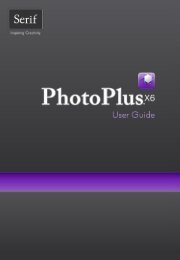Create successful ePaper yourself
Turn your PDF publications into a flip-book with our unique Google optimized e-Paper software.
166 Making Images for the Web<br />
The Export Optimizer provides special GIF options that help you preserve semitransparency<br />
if you’ve employed antialiasing or feathering in your original image.<br />
The .GIF format still wants "all or nothing," but you can opt to dither the alpha<br />
(transparency) channel and/or select a matte colour with which semi-transparent<br />
pixels will be smoothly blended. Pixels that aren’t 100% transparent will still end<br />
up opaque, but the image will look a lot better.<br />
Finally, .GIF is a "multi-part" format, which means one file can store multiple<br />
images. That's what makes it a good candidate for use in Web animations.<br />
.JPG format<br />
The .JPG or .JPEG (Joint Photographic Experts Group) file format, like .GIF, is<br />
universally supported in Web browsers. Unlike .GIF, it encodes 24-bit images but<br />
is a “lossy” format (i.e. it discards some image information) depending on the<br />
selected Quality setting (this controls compression). .JPG is clearly the format of<br />
choice for full-colour photographic images. For "black and white" (256-level, 8-bit<br />
greyscale) photos, it has no particular advantages over .GIF.<br />
The unique aspect of exporting as a JPG is the slider control you use to choose a<br />
Quality setting. At one end of the scale, the export applies maximum compression<br />
(0% Quality) and produces an extremely small (but quite ugly) image. At the other<br />
end, 100% quality means that lossless uncompressed export is possible, but file<br />
sizes are relatively much larger, although still compact compared to BMPs, for<br />
example. When choosing a quality setting for .JPG export, keep in mind the<br />
number of times you expect to be re-exporting a particular image. A photograph<br />
may look fine in the Export Optimizer the first time you export it, e.g. at 60%<br />
Quality, but after several such saves, you'll really see a quality loss.<br />
<strong>PhotoPlus</strong> also supports the new JPEG 2000 (.JP2, .J2K) format, which uses<br />
wavelet compression and reduces file sizes significantly better than .PNG (see<br />
below) but does not support transparency. This format can store channels of<br />
data—such as ICC profiles!
















